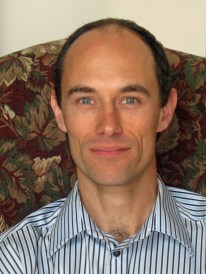Cooperation Dynamics Key to Sustaining Natural Resources
December 15, 2016
ORONO — Cooperation in groups of resource users may be key to sustaining the environment, according to a new study using mathematical and computational modeling.

Timothy Waring, an associate professor at the University of Maine, is the lead developer of the new model that simulates how societies with different social structures and institutions manage their resources.
Waring, faculty at the Senator George J. Mitchell Center for Sustainability Solutions and the School of Economics, leads a group of researchers from around the globe that is building and testing a theory of sustainability in an effort to solve these social-environmental problems more effectively.
“Most sustainability challenges like pollution or over harvesting a natural stock like fish or timber are what we call social dilemmas” says Waring. “These are situations in which what is good for the group—the town, the nation, or the planet—conflicts with what is best for the individual.”
Cooperation solves social dilemmas. Waring uses the scientific study of cooperation to improve our understanding of the how, when and where of sustainability. How did the Maine lobster fishery develop the successful conservation measures it is so well known for? Why did Maine blueberry producers choose to forgo profits to fund a cooperative blueberry research program?
“We need a recipe for sustainability,” says Waring. “My research is to develop and test that recipe—a theory of sustainability, of when and why sustainability happens. When do people cooperate in how they use the environment?”
He adds, “Usually, we assume that everyone has to cooperate to save environmental resources but what we found was that sustainable resource use was more likely to emerge when societies were broken up into multiple groups, like states in the United States, or countries in Europe.”
Waring compares the United Nation’s first climate change talks at the Rio Earth Summit in 1992, which took a top-down approach and was viewed largely as a failure, with the Paris climate change agreement in 2015, which was successful in part because it emerged from the grassroots, amongst smaller groups.
“Cooperation is easier in small groups, easier with familiar people, and with similar people. And, cooperation is more durable when it is supported by social and institutional factors as well.”
His newest work, along with coauthors Sandra Goff of Skidmore College and Paul Smaldino of the University of California, Merced, was published recently in the journal Ecological Economics.
Says Waring, “Our simulation suggests three major factors tend to help sustainability emerge: when the resource dilemma impacts groups most, when those groups learn from failure, and when they learn from each other.”
Now Waring is teaming up with other researchers from UMaine and the Mitchell Center to put the theory to the test by studying some of Maine’s key natural resources—lobsters, blueberries, and local food. What they are finding matches the three major factors that the theory shows fosters sustainability.
In the local food industry, Waring teamed up with Portland area local food entrepreneurs. “We are finding that many people buy local food for altruistic reasons—they want to support small farmers, and that is an act of cooperation” Waring says. “Cooperation is hard to keep up if you act alone. But, people who join small buying clubs often find it easier to buy local food. Again, groups make the difference for cooperation.”
In the lobster industry, Waring and economic anthropologist James Acheson have found that learning between groups of lobstermen about the best ways to use and protect their lobsters helped lead to better conservation laws.
In the blueberry industry, Waring and agricultural researcher Sam Hanes found that cooperation between Maine’s blueberry producers solved a major pest outbreak, but only after a statewide industry crisis force their hand.
Waring hopes his theory may make it easier to assemble cooperative groups that can manage resources sustainably at any level, from fisheries to nations.
“However, our simulation model has a sobering message,” says Waring. “Sustainable societies only emerged after a global resource collapse. So, we have to use these findings to achieve sustainability sooner. Group-level dilemmas, learning from failure, and learning between groups—that’s the best recipe we have.”
This research is also supported by the National Institute for Mathematical and Biological Synthesis (NIMBioS) and the National Socio-Environmental Synthesis Center (SESYNC).
For more on Waring’s research, visit his website.
For more information, contact David Sims, Communications and Outreach Coordinator, Senator George J. Mitchell Center for Sustainability Solutions at (207) 581-3244 or david.sims@maine.edu.
